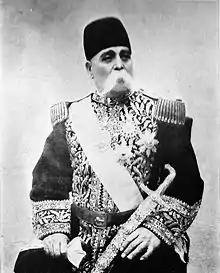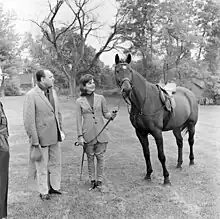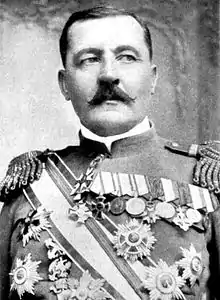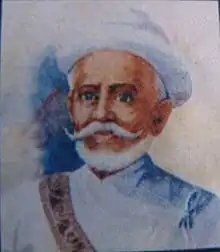



Sardar, also spelled as Sardaar/Sirdar (Persian: سردار, Persian pronunciation: [særˈdɑr], 'commander', literally 'headmaster'), is a title of royalty and nobility that was originally used to denote princes, noblemen, chiefs, kings and other aristocrats. It has also been used to denote a chief or leader of a tribe or group. It is used as a Persian synonym of the title Emir of Arabic origin.
The term and its cognates originate from Persian sardār (سردار) and have been historically used across Persia (Iran), the Ottoman Empire and Turkey (as "Serdar"), Afghanistan (as "Sardar" for a member of the royal Mohammadzai clan in meaning of noblemen), Mesopotamia (now Iraq), Syria, South Asia (Pakistan, India, Bangladesh and Nepal), the Caucasus, Central Asia, the Balkans and Egypt (as "Sirdar").[2]
Amongst Sikhs, the term began to be adopted due to Afghan influence in the mid-18th century to signify a leader of a Jatha or Misl and gradually replaced other prior used terms for these positions, such as 'Jathedar' and 'Misldar'.[3] The term sardar was used by Sikh leaders and generals who held important positions in various Sikh Misls. The title is still commonly used by Sikhs today. Though historically signifying one's military rank or membership of a locally important family, in the contemporary period the title is used widely in India and neighbouring countries for any respected Sikh male. Sardar was also used to refer to generals of the Maratha Empire. After the decline of feudalism, sardar later indicated a Head of State, a Commander-in-chief, and an army military rank. As a military rank, a sardar typically marked the Commander-in-Chief or the highest-ranking military officer in an army, akin to the modern Field Marshal, General of the Army or Chief of Army. The more administrative title Sirdar-Bahadur denoted a Governor-General or Chief Minister of a remote province, akin to a British Viceroy.
In Himalayan mountaineering, a sirdar is a local leader of the Sherpas.[4] Among other duties, he records the heights reached by each Sherpa, which factors into their compensation.
Princes
- The Kapurthala State, have been ruled by kings of state styled Sardar. For example, the king of Kapurthala used the title of Sardar.[5]
Examples of regional use
- In Baluchistan, the title Sardar marked the chief of his tribe.
 Portrait of a Sikh sirdar, ca.1820
Portrait of a Sikh sirdar, ca.1820 - In the Royal Afghan Kingdom, the original Nishan-i-Sardari (Order of the Leader), founded by King Amanullah in 1923, was bestowed for exceptional service to the Crown by the Afghan monarch. Recipients enjoyed the titles of Sardar-i-Ala or Sardar-i-Ali before their names and also received grants of land. The original Order was disbanded in 1929, and was later revived by King Muhammad Zahir Shah.
- In Ottoman Turkey, Serdar was a rank in Bosnia Eyalet with Herzegovina Eyalet, later Bosnia Vilayet, encompassing entire Bosnia and Herzegovina, and parts of Montenegro and Serbia, as well as in other parts Ottoman Montenegro, Serbia, and other lands. Serdar was also used in the Principality of Montenegro and the Principality of Serbia as an honorary "title" below that of Vojvoda. For example, Janko Vukotić who was a military leader and former prime minister of Montenegro with title of Serdar. However, these were not noble titles as there was no nobility in Serbia and Montenegro and no hereditary titles apart from those borne by members of the reigning families of both countries.
- In Persia, Sardar-i-Bozorg was the title of both Hossein Khan Sardar and his brother Hasan Khan Qajar. Both were uncles of Agha Khan Qajar, the King-Emperor of Persia and the Commander-in-chief under Emperor Fat′h-Ali Shah Qajar in the Russo-Persian Wars of 1804 and 1826.
- In Punjab, village chiefs, military commanders, and noble personalities were referred to as Sardars. The title is commonly used by both Muslims and Sikhs.
- The early feudal Maratha Empire prior to Peshwa administration (1674–1749) used the title Sardar to identify an imperial court minister with military and diplomatic functions. If granted land (jagir), the title Sardar also marked a feudal superior responsible for administration, defense and taxing of the granted territory (equivalent to the European title Count, from the French comte meaning the "companion" or delegate to the Emperor that administered a county). These Sardars of the early Maratha Empire were life peers; the title was not hereditary.
- If the Sardar was appointed to Commander-in-Chief of all Maratha forces, the style Senapati was used in combination (e.g., Sardar Senapati or Sarsenapati Khanderao Yesajirao Dabhade. The title Senapati is a primogeniture hereditary title, as is evidenced by the current Senapati Shrimant Sardar Padmasenraje Dabhade of Talegaon Dabhade.
- In the Maratha Empire, the more administrative role of Sirdar-Bahadur denoted a Governor General or Chief Minister of a remote province; this best equates to a Mughal Subahdar or British Viceroy in function and rank.
- The title Sirdar was used by Englishmen to describe native noblemen in British India (e.g., Sirdars of the Deccan).
Aristocrats
- In the Hazara Division of Pakistan, the word Sardar is used by the Karlal tribe, traditionally, to stress their upper-caste status.
- In the small district of Sudhanoti, Kashmir, Sardar is used by the hybrid Sudhan tribe. Also, Poonch families in this region use Sardar at the beginning of their names.
- Similarly Sardar is used by Khattar tribe noble men, native to the districts of Attock and adjacent areas of Rawalpindi.
- Sardar was used for important political, tribal, military and religious officers rankings by the Sikhs during the period of Maharaja Ranjit Singh.
Head of state
- In Persian, Sardar i-Azam was occasionally used as an alternative title for the Shahanshah's Head of government, normally styled Vazir i-Azam, notably in 1904-06 for a Qajar prince, Prince Major General Abdol Majid Mirza.
- Vallabhbhai Patel, the first Deputy Prime Minister of India was referred to as Sardar Patel; he is also now known as the "Iron Man of India".
- Sadr-e-Riyasat was the title of one Constitutional Head of State of the princely state of Kashmir, Yuvaraj Shri Karan Singhji Bahadur, who was appointed as Heir Apparent in 1931. After his father had acceded to India, ending the sovereign Monarchy, Regent in 1949 to 1956. Sardar-i-Riyasat 1956 to 1965 (succeeded on the death of his father as Maharaja of Jammu and Kashmir, 1961, no longer carrying any hereditary power), next Governor of the Indian constitutive State of Jammu and Kashmir 1965 to 1967.
- Mohammed Daoud Khan of Afghanistan had the title of Sardar as president.
- Saparmurat Niyazov, the authoritarian ruler of Turkmenistan in 1990–2006, carried a few glorifying titles, one of which was Serdar (“Leader”).[6]
- Sardar Sulakhan Singh Puar of Sikh Empire had the title of Sardar. Among Sikhs, Sardar is the title used by Sikh nobles, Military leaders & village chiefs.
Military title


- Sardar is a title used by the Koli caste of Maharashtra during the reign of Bahamani and Ahmednagar Sultanates conferred by the Sultans of Both sultanates to the Koli fortkeeper or Koli protecters of hilly tracts.[7][8][9][10]
- The later Maratha Empire under Peshwa administration (1749–1818) used the title Sardar to denote a Field Marshal or General of the Army.
- Sirdar was the official title of the British Commander-in-Chief of the Anglo-Egyptian army.[2]
- The title Serdar is also common amongst Ottomans in referring to a Commander-in-Chief. The Serbs adopted this usage from the Ottomans (e.g. Serdar Janko Vukotić).
- In Turkish, Serdar or Serdar-i-Ekrem was the title of the Commander-in-Chief in several military operations throughout the Ottoman Empire history.
- In Afghanistan, Sardar-i-Salar meant Field Marshal or General of the Army.
- In Iran, Sardar is used to address Islamic Revolutionary Guard Corps high-ranking officers. (see List of senior officers of the Islamic Revolutionary Guards)
- During the time of Maharaja Ranjit Singh, the term Sardar became even more common as a title given to Sikh men. Although it was officially reserved to address a high-ranking official or a commanding chief such as a general or officer.[11]
Modern usage
- The term Sardar is today used to refer to adult male followers of the religion of Sikhism, as a disproportionate number of Sikhs have honorably served in many high-ranking positions within the Indian Army. Notable examples include Generals Joginder Jaswant Singh and Harbaksh Singh.
- In Himalayan mountaineering, a Sirdar is the local leader of the Sherpas and porters.[12] Among other duties, he records the heights reached by individual Sherpas, which dictates the amounts the Sherpas will be paid.
- The title Sardar was granted to various writers and poets during Rana rule in Nepal
- HMS Sirdar was a World War II Royal Navy submarine.
- HMS Sirdar is a fictional Royal Navy destroyer in the novel The Guns of Navarone
- "Siridar" is a title of planetary rulers in Frank Herbert's Dune. The Padishah Emperor's elite troops are also called the Sardaukar.
- Sardar is now used for leaders of a tribe in Pakistan, Afghanistan, and Indian administered Kashmir. Many communities and tribes in Pakistan, especially in Punjab and Kashmir, use this title, including Dogar, Jat, Gujjar, Tanoli, Mughal and Sikh.
See also
References
- ↑ "Jackie Kennedy receives horse from governor of Pakistan – Mar 23, 1962 – HISTORY.com". history.com. Archived from the original on 2016-03-17.
- 1 2 Chisholm, Hugh, ed. (1911). . Encyclopædia Britannica. Vol. 25 (11th ed.). Cambridge University Press. p. 154.
- ↑ Singh, Harbans. The Encyclopedia of Sikhism. Vol. 2: E-L. Punjabi University, Patiala. pp. 362–3.
- ↑ Sayre, Woodrow Wilson (1964). Four Against Everest. Englewood Cliffs, NJ, USA: Prentice-Hall. Library of Congress Catalog Card No: 64-15208 223.
- ↑ "Royal Kapurthala Dynasty History".
- ↑ Cummings, Sally N. (2010). Symbolism and Power in Central Asia: Politics of the Spectacular. Milton, United Kingdom: Routledge. pp. 91–92. ISBN 978-0415575676.
- ↑ Hassan, Syed Siraj ul (1989). The Castes and Tribes of H.E.H. the Nizam's Dominions. New Delhi, India: Asian Educational Services. pp. 332: The Koli country was then known as Bávan Mávals, or fifty - two valleys, each under a naik . These naiks held a good position, both in the Bahamani and in the Ahmednagar kingdoms, ranking among the nobles called ' Sardars ' and Mansabsar. ISBN 978-81-206-0488-9.
- ↑ Behera, Maguni Charan (2019-11-09). Tribal Studies in India: Perspectives of History, Archaeology and Culture. New Delhi, India: Springer Nature. pp. Bahamani Sultans conferred the title of Sardar to the Koli chiefs who held the charge of hilly tracts. ISBN 978-981-329-026-6.
- ↑ Heredia, Rudolf C.; Ratnagar, Shereen (2003). Mobile, and Marginalized Peoples: Perspectives from the Past. New Delhi, India: Manohar Publications. pp. 160: Raja Vikramajit, Shahjahan's governor of Gujarat, had to conduct an expedition in 1622 against some Kolis north of Ahmedabad who had ... The Bahmanis conferred the rank of Sardar on Koli chiefs who held charge of hill tracts. ISBN 978-81-7304-497-7.
- ↑ Robinson, Frederick Bruce (1978). Adaptation to Colonial Rule by the "wild Tribes" of the Bombay Deccan, 1818–1880: From Political Competition to Social Banditry. New Delhi, India: University of Minnesota. pp. 158–360: The men to be appointed over these jurisdictions were to be selected from among the existing Koli Sardars (men of influence), whom this official characterized both as having " acquired rank and substance.
- ↑ www.thesardarco.com. "What is a Sardar?". The Sardar Co. Retrieved 2020-04-03.
- ↑ Sayre, Woodrow Wilson (1964). Four Against Everest. Englewood Cliffs, NJ, USA: Prentice-Hall. p. 223. Library of Congress Catalog Card No: 64-15208.
